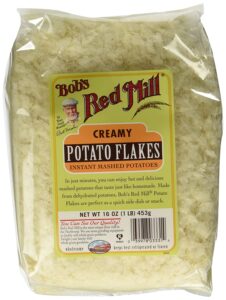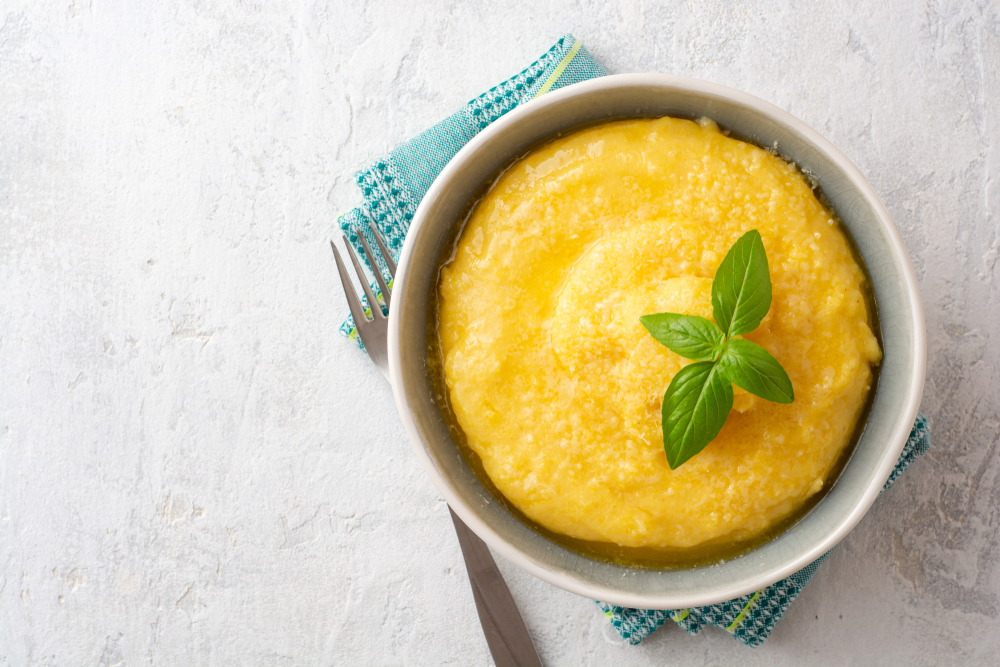Polenta is a traditional Italian dish of boiled cornmeal. You can eat it hot like a porridge or place the cooked polenta into a loaf pan. Once it is solidified, it can be cut into slices that can be baked, fried, or grilled.
Polenta is gluten-free. There is a chance of gluten contamination in some brands, so look for the gluten-free label on packages to ensure safety. Bob’s Red Mill and Roland Foods Polenta are gluten-free. The best alternatives to polenta include House Autry Ground Grits, Nature’s Earthly Choice Cauliflower Rice, Bob’s Red Mill Potato Flakes, and Honest Earth Mashed Sweet Potatoes.
Let’s talk about polenta’s health benefits, how you can make or eat polenta (if this is a new grain for you), as well as other gluten-free alternatives to polenta. Let’s dig in!
Contents
Corn and Gluten
Polenta is made from milled corn. Corn does not contain gluten but does contain a plant protein called zein. In rare cases, those with sensitivities will have a similar reaction to this protein as they do with gluten. Everyone’s body is different, so check with your medical practitioner and take care when eating polenta until you are sure of your reactions.
Is Polenta Healthy?
Polenta has carbohydrates and protein. If you are on a low-carb or keto diet, it might not be the best choice, but it has some benefits from a purely nutritional perspective.
- Those carbohydrates are complex, meaning they break down slowly in your digestive system and thus do not spike your blood sugar levels.
- Polenta is low in calories and fat (assuming you cook it with water and do not add butter or cheese).
- Polenta is a good source of fiber, which helps with a healthy gut.
- Polenta has Vitamin A, iron, magnesium, and zinc. While the amounts are a small portion of your recommended daily allowance, every little bit adds up.
- Milled corn is a good source of carotenoids, an antioxidant that reduces your risk of some cancers.
Polenta Nutritional Information
Bob’s Red Mill Gluten Free Yellow Corn Grits / Polenta
Bob’s Red Mills sells corn grits/polenta that has gluten and some that are gluten-free. This is a dry, quick-cooking recipe. You can prepare it in about 5 minutes.
Ingredients:
- Corn
Nutrition (per ¼ cup):
- 150 Calories
- 5g Fat
- 0mg Cholesterol
- 0mg Sodium
- 32g Carbohydrates (2g Fiber)
- 3g Protein
- 70mg Potassium
Colavita Polenta
This is a gluten-free polenta that is ready in five minutes.
Ingredients:
- Pre-cooked cornflour
Nutrition (per ¼ cup):
- 130 Calories
- 0g Fat
- Omg Cholesterol
- 0mg Sodium
- 28g Carbohydrates (1g Fiber)
- 2g Protein
- 41mg Potassium
Roland Foods Fine Grain Yellow Polenta
This is a fine-grain, quick-cooking polenta that is gluten-free.
Ingredients:
- Cornmeal
Nutrition (per 3 Tbsp):
- 110 Calories
- 1g Fat
- 0mg Cholesterol
- 10mg Sodium
- 23g Carbohydrates (2g Dietary Fiber)
- 2g Protein
- 86mg Potassium
San Gennaro Polenta
This traditional Italian polenta is gluten-free, fat-free, and pre-made in a tube. You can slice it and add toppings.
Varieties:
- Traditional
- Tomato Garlic
- Basil Garlic
Ingredients:
- Water
- Yellow Cornmeal
- Salt
- Tartaric Acid
- Ascorbic Acid
- Beta Carotene
Nutrition (1/5 of a tube is a serving):
- 70 Calories
- 0g Fat
- 0mg Cholesterol
- 260mg Sodium
- 16g Carbohydrates
- 2g Protein
- .2mg Iron
- 30mg Potassium
Ancient Harvest Traditional Italian Polenta
This is another polenta that comes in a tube. It is pre-cooked, so you can slice it and heat it. Serve covered in a sauce. This brand is organic, kosher, fat-free, gluten-free, and non-GMO.
Ingredients:
- Water
- Organic yellow cornmeal
- Salt
- Tartaric acid
- Ascorbic acid (Vitamin C)
- Beta carotene (Vitamin A)
Nutrition (per 2 ½ slices or 1/5 of the package):
- 70 Calories
- 0g Fat
- 0mg Cholesterol
- 310mg Sodium
- 15g Carbohydrates (1g Dietary Fiber, 1g Sugars)
- 2g Protein
Arrowhead Mills Organic Yellow Corn Grits
This is the same as polenta, gluten-free, kosher, and organic.
Ingredients:
- Organic Degermed Yellow Corn Grits
Nutrition (per ¼ cup):
- 140 Calories
- .5g Fat (.5g Saturated)
- 0mg Cholesterol
- 5mg Sodium
- 31g Carbohydrates (3g Fiber)
- 2g Protein
- 34mg Potassium
Gluten-Free Alternatives to Polenta
In addition to the alternatives listed below, other suggestions include oatmeal and cream of wheat. If you intend to eat polenta for breakfast, these might be good options as well.
Grits
Grits are made from white corn or hominy, as opposed to yellow corn. The flavor is milder, and the texture is mushier when cooked.
House Autry White Stone Ground Grits
Ingredients:
- White Corn
Nutrition (per ¼ cup):
- 150 Calories
- 1g Fat
- 0g Cholesterol
- 0mg Sodium
- 31g Carbohydrates (3g Dietary Fiber)
- 3g Protein
Mashed Potatoes
While I’d suggest making mashed potatoes from real potatoes, here is a gluten-free instant potato option that will be quick.
Bob’s Red Mill Potato Flakes
 Non-GMO, Vegan, and Kosher. The ingredients are gluten-free, but it’s not labeled as such.
Non-GMO, Vegan, and Kosher. The ingredients are gluten-free, but it’s not labeled as such.
Ingredients:
- Dehydrated Potatoes
Nutrition (per 1/3 cup):
- 70 Calories
- 0g Fat
- 0g Cholesterol
- 0mg Sodium
- 15g Carbohydrates (1g Dietary Fiber)
- 1g Protein
Sweet Mashed Potatoes
Again, the healthiest version of sweet potatoes is homemade, but here is a gluten-free alternative.
Honest Earth Homestyle Mashed Sweet Potatoes
- Sweet Potatoes
- Water
- Egg
- Brown Sugar
- Butter
- Sugar
- Nonfat Dry Milk
- Vanilla
- Salt
Nutrition (per ½ cup):
- 120 Calories
- 5g Fat (1g Saturated)
- 5mg Cholesterol
- 200mg Sodium
- 25g Carbohydrates (3g Fiber, 14g Sugars)
- 2g Protein
- .1mcg Vitamin D
- .7mg Iron
- 400mg Potassium
- 160mcg Vitamin A
Pureed Cauliflower
Again, it’s really easy to buy a whole head of cauliflower, steam it and place it in a ricer or blender to achieve the perfect texture, but here’s a packet of frozen riced cauliflower that makes the whole process easier. This is also great for a low-carb diet.
Nature’s Earthly Choice Cauliflower Rice
- Cauliflower
- Water
- Malic Acid
Nutrition (per ½ cup):
- 25 Calories
- 0g Fat
- 0mg Cholesterol
- 30mg Sodium
- 5g Carbohydrates (2g Dietary Fiber, 2g Sugars)
- 2g Protein
- 23mg Calcium
- 311mg Potassium
Pumpkin Puree
Depending on your dish, organic pumpkin (or other squash) is an alternative to polenta as well. I can imagine a stew over pumpkin puree. This company makes butternut squash puree and sweet potato puree in cans as well for variety. As you will see from the label, the pumpkin is loaded with Potassium and Vitamin A.
Farmer’s Market Foods Organic Pumpkin Puree
- Organic Pumpkin Puree
Nutrition:
- 50 Calories
- 0g Fat
- 0mg Cholesterol
- 0g Sodium
- 12g Carbohydrates (4g Dietary Fiber, 4g Sugars)
- 1g Protein
- 29mg Calcium
- .6mg Iron
- 313mg Potassium
- 339mcg Vitamin A
How to make Polenta from Scratch
Traditional Polenta made from scratch takes few ingredients but takes a lot of time spent stirring the pot over the stove.
- Bring slightly salted water to a boil on the stove.
- Add polenta to the water while whisking to remove lumps
- Reduce heat and whisk until the polenta starts to thicken. This should take about 5 minutes.
- Cover and cook for 30 minutes, whisking every 5 minutes until the texture is creamy and the grains are tender.
Polenta can be made from coarse or refined grains.
The options found here are primarily quick-cooking polenta. The grains are more processed and cook in anywhere from one to five minutes. The tubes of pre-made polenta are already cooked and require some heating up.
What Can I Make with Polenta?
Polenta is excellent plain and is part of the grain family. While adding butter and cheese will make it delicious, that will add calories. You can top it with a stew or tomato sauce. Plenty of recipes show a bowl of creamy polenta with meat, vegetables, or various sauces on top.
Some have polenta for breakfast. It can be served sweet with fruit, spices, and seeds stirred in, or savory with bacon, eggs, or topped with vegetables.
Pre-cooked polenta can be sliced and grilled. They can even be sliced into thin strips and baked as an alternative to French fries!
What is a Polenta Maker?
Those that desire traditional polenta (which is arguably a bit healthier due to less processing) but don’t want to spend 45 minutes over the stove stirring can invest in a polenta maker. This is basically a pot with an attachment on the top with an electric hook that does the stirring for you. With all of the quick-cooking polentas on the market, this gadget is most useful for traditionalists.
Related Questions
Is Polenta Keto-Friendly?
By the definition of keto, the focus is on a higher fat, lower carbohydrate foods. Polenta has no fat as prepared, and the number of carbohydrates varies but is not insignificant.
Can I use Couscous as a Substitute for Polenta?
While they look similar, couscous is pasta, and polenta is a grain. They will not have the same texture or taste. With some dishes, it might taste delicious, though. A better substitute is semolina, which is the ingredient in many kinds of pasta, but more emulates the taste and texture of polenta. Scroll back up for more on semolina.
Can I use Semolina as a Substitute for Polenta?
Many sites suggest substituting semolina for polenta. While the texture might be the same, I find conflicting reports on whether semolina is gluten-free. I did find a brand that claims to be gluten-free, but research indicates that Durum Wheat Semolina does indeed contain gluten.
What’s the Difference Between Cornmeal and Polenta?
Some polentas listed cornmeal as an ingredient, and while they are similar, polenta is more coarsely ground, which results in a sturdy texture in your dishes. If you are out of cornmeal and have polenta in the cupboard, it can be a substitute, but the texture will be different.




